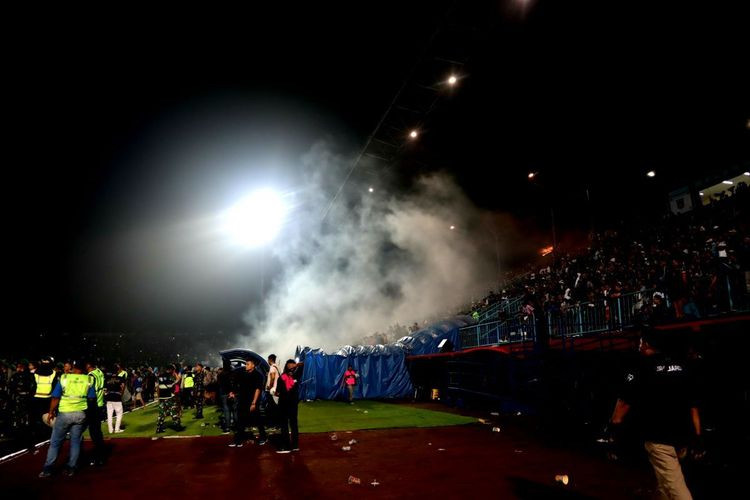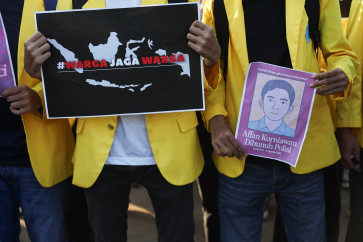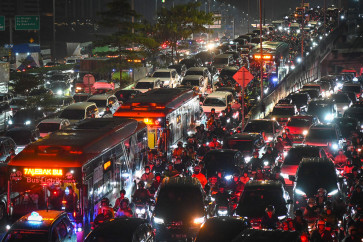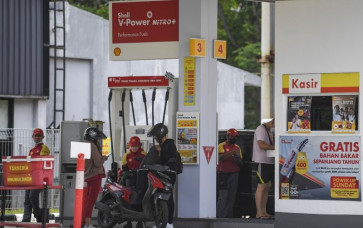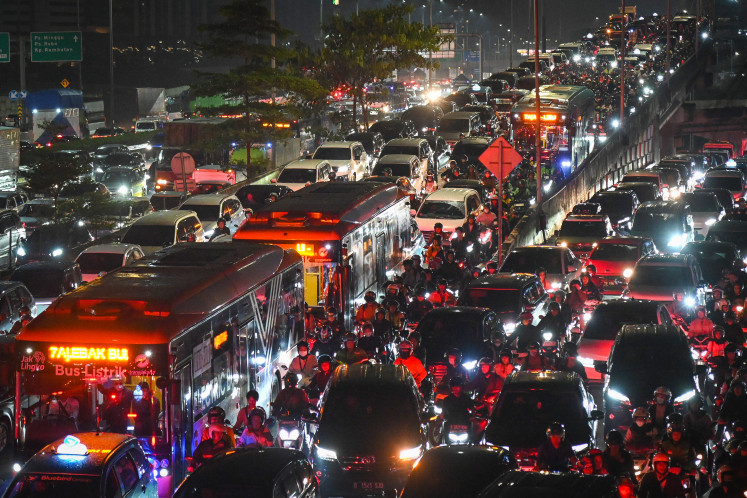Popular Reads
Top Results
Can't find what you're looking for?
View all search resultsPopular Reads
Top Results
Can't find what you're looking for?
View all search resultsWe must ban tear gas use in sports stadiums, for good
Police crowd control tactics affect countless victims worldwide every year.
Change text size
Gift Premium Articles
to Anyone
O
n Oct. 1, 131 people died and more than 300 were injured in a stampede in Kanjuruhan Stadium in Malang, East Java. The reason? Tear gas.
Police fired tear gas into a packed stadium when fans invaded the soccer field at the end of a game. Instead of controlling the crowd, the police caused chaos and a mad rush of crowds heading for the exits. A stampede ensued, crushing hundreds of people. Among the dead were at least 40 children.
A few days later, on the other side of the planet, hundreds were injured and a man died of cardiac arrest in similar circumstances in a stadium in Argentina as a result of people trying to escape from tear gas. This time, the canisters were fired just outside the stadium but the winds blew the smoke in.
On the eve of the Qatar World Cup and in the face of FIFA’s inadequate response to the Malang tragedy, national law enforcement in every country must acknowledge the dangers of chemical irritants. Tear gas must be explicitly banned in sports stadiums. FIFA should demand this discussion and stand up for its fans.
The events surrounding the authorities’ intervention during the Malang derby remain under investigation. In the meantime, the Commission for Missing Persons and Victims of Violence (KontraS) led an independent group inquiry on the police operation and discovered a series of irregularities.
The police inside the stadium were armed with tear gas and ready for deployment as early as the second half of the game, before home team Arema lost and before fans took to the pitch. The police claimed to have reacted to violent fans intimidating players and staff. Interviewed witnesses state that many fans had gone to the pitch to show support for their defeated team when a police officer shot the first gas canister into the packed stands. This sent people scrambling toward narrow evacuation routes, some of which were sealed shut.
In reaction to the outcry caused by the tragedy, the government formed the Joint Independent Fact Finding Team (TGIPF) led by the Law and Human Rights minister to investigate the events. The team issued no conclusions regarding the alleged crimes committed by security forces, despite evidence pointing to high-level individuals.
Unfortunately, the irregularities detected by KontraS are far from isolated. Police crowd control tactics affect countless victims worldwide every year. The dire health and human rights impacts of crowd control weapons have been documented and exposed by our teams at the International Network of Civil Liberties Organization (INCLO) and Physicians for Human Rights (PHR).
Our research demonstrates that tear gas can cause severe pain, blindness and suffocation.
Decades of use have resulted in thousands of injuries, permanent disabilities and even death. But nowhere are the deaths and injuries more profound than when tear gas is used in enclosed spaces.
Temporary blindness and pain result in severe distress and force people away from the gas. When tear gas is fired by multiple officers in multiple areas of a stadium or other enclosed areas, it leaves no clear safe exit. The design of stadiums, with narrow exits scattered across the field and stadium, makes it impossible for large numbers of people to exit quickly.
The combination of a painful chemical gas that blinds and unnerves people and small, unclear exits is a recipe for disaster. Tragically, it is a disaster we have seen over and over again.
The most recent events at Kanjuruhan Stadium revive the memory of a long string of soccer stadium deaths across the globe due to tear gas stampedes: the Estadio Nacional tragedy in Peru (1964) claimed over 300 victims and in the 2001 Ellis Park Stadium disaster in South Africa, 43 victims were crushed in a tear gas stampede.
That same year, the Accra Sports Stadium disaster in Ghana claimed the lives of 127 fans in similar conditions. Twelve people lost their lives at the FIFA World Cup qualifier in Zimbabwe in 2000 and 22 more in the Ivory Coast during a FIFA and African Cup of Nations qualifying match in 2009. The 30 June Stadium stampede in Egypt killed 28 stadium-goers in 2015.
The list goes on and, in every case, these deaths could have been avoided.
The inherent dangers of several types of crowd control weapons were extensively documented in the 2016 report "Lethal in Disguise" by the PHR and the INCLO. Since 2020, the United Nations guidance on the use of less-lethal weapons in law enforcement establishes a series of guidelines and recommendations for the proper deployment of these devices by state authorities. The guidance could not be any clearer in recommending against the use of chemical irritants in sports venues: “A stampede may result when irritants are used against a crowd in an enclosed area, such as a football stadium.”
However, law enforcement has yet to catch up. When they see fans getting upset, they frequently turn to tear gas, believing it to be safe. It is not.
Clear guidelines must be established for stadiums. The first rules are straightforward and evidence-based: never use tear gas or any chemical irritants, communicate with the crowd and de-escalate and allow for safe exits before disrupting large numbers of people.
The role of the police is always to de-escalate tension and make spaces safe. Sometimes their interventions generate the opposite, chaos and panic, with grave consequences and severe casualties. Respecting the guidelines for the safe use of chemical irritants is the only way to neutralize their deadly potential.
FIFA’s security policies already advise against the use of tear gas in or around stadiums. But it has done little to sanction those that do not comply nor elevate this issue with international and domestic leagues. National level law enforcement would do well to pay attention and heed this call.
Fans depend on them to ensure their safety.
***
Rohini Haar is an emergency physician with expertise in health and human rights and a research fellow at the Human Rights Center at UC Berkeley’s School of Law. Fatia Maulidiyanti is coordinator at the Commission for the Disappeared and Victims of Violence (KontraS).

